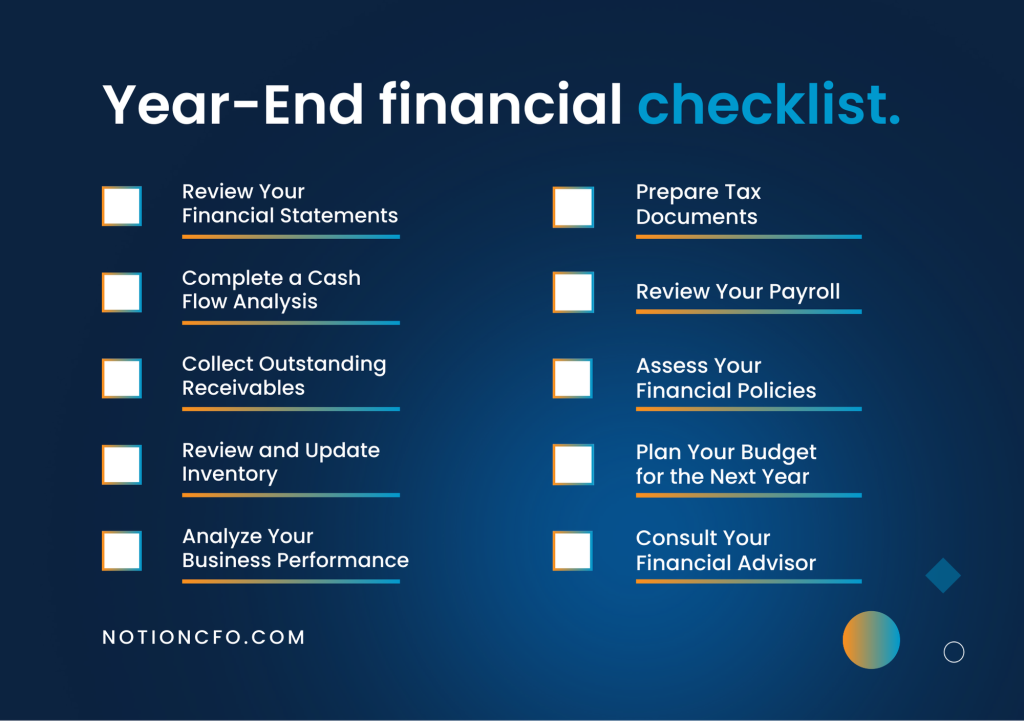As we enter the second half of the year, you should be thinking about wrapping up your financials and preparing for the year ahead. Ensuring that all financial elements are correctly accounted for in your business can prevent costly mistakes and set the stage for a successful new fiscal year.
This essential year-end financial checklist is designed to guide you through 10 key steps, ensuring you close your books with confidence and efficiency.
1. Review Your Financial Statements
Begin your year-end financial review by examining your main financial statements: the balance sheet and income statement. These documents are necessary as they provide a comprehensive view of your business’s financial health and are foundational for making informed decisions.
Details to Consider
- Balance Sheet: Check the accuracy of all entries related to assets, liabilities, and equity. Confirm that your assets match the sum of liabilities and equity, ensuring the balance sheet balances. Look for any unusual changes in asset values or liability levels that could indicate errors or require further investigation.
- Income Statement: Analyze your revenue streams and expenses throughout the year. Ensure that all income and expenses are accurately recorded and categorized. This statement helps you understand your business’s profitability, highlighting areas where you are over or under budget and identifying trends in income or expenditure.
Analytical Approaches
- Comparative Analysis: Compare the current year’s data with previous years to spot trends, growth patterns, and potential red flags. This comparison can reveal insights into how your business is evolving and help you make strategic adjustments.
- Ratio Analysis: Utilize financial ratios derived from these statements to assess your business’s operational efficiency, liquidity, profitability, and solvency. Ratios like the current ratio, debt-to-equity ratio, gross profit margin, and others provide quick metrics to gauge financial health.
- Variance Analysis: To understand the differences between planned figures and actual outcomes, conduct variance analysis. This analysis can identify areas where the business performed differently than expected, providing opportunities for corrective actions.
2. Cash Flow Analysis
Cash flow analysis is crucial in ensuring your business maintains healthy liquidity throughout the year. Adopting a forward-looking approach with a 12-week or longer weekly cash flow forecast can provide dynamic insights into your financial health.
Details to Consider
- Review Past Forecasts Against Actuals: Regularly compare your previous cash flow forecasts to actual results to identify any recurring discrepancies or patterns. This analysis helps refine the accuracy of future forecasts.
- Update Revenue and Expense Estimates: Mid-year, reassess your revenue and expense estimates to ensure they still align with current business operations and market conditions. This helps in adjusting your forecasts to better reflect upcoming financial realities.
- Incorporate Year-End Specific Items: Make sure to include any anticipated year-end expenses, such as bonuses, holiday-related costs, or annual maintenance expenses, in your cash flow forecast. This ensures you are not caught off guard by significant outflows at the year’s end.
Analytical Approaches
- Trend Analysis: Use trend analysis to track the effectiveness of your cash flow management over time. Identifying trends in cash inflow and outflow patterns can help predict future financial needs and challenges.
- Scenario Planning: Implement scenario planning in your cash flow forecasting to account for best-case, worst-case, and most likely scenarios. This approach helps prepare your business for different potential financial situations, enhancing your resilience against unexpected changes.
- Regular Updates and Reviews: Set a routine (monthly or quarterly) to review and update your cash flow forecasts. This continual refinement process helps keep your forecasts relevant and reliable as an active tool for financial decision-making.
3. Collect Outstanding Receivables
Managing accounts receivable effectively ensures steady cash flow. Collecting outstanding payments before year-end is crucial to improving your financial position.
Details to Consider
- Invoice Review: Check all issued invoices for the year and follow up on any that remain unpaid or partially paid.
- Communication with Clients: Remind clients with outstanding invoices via email, phone call, or letter.
Analytical Approaches
- Aging Report: Utilize an aging report to see how long invoices have been outstanding. This can help prioritize collection efforts based on the overdue status.
- Offer Settlements: For long-overdue accounts, consider offering settlement options at a discounted rate to encourage payment.
4. Review and Update Inventory
An accurate inventory count is essential for correct financial reporting and ensuring that your business isn’t carrying excess stock or suffering from stock shortages.
Details to Consider
- Physical Inventory Count: Conduct a thorough physical inventory count to verify stock levels and condition.
- Inventory Valuation: Assess the value of the inventory, taking into account any obsolete or damaged items that need to be written down.
Analytical Approaches
- Inventory Turnover Ratio: Calculate the inventory turnover ratio to understand how quickly inventory is being sold and replenished. A high turnover ratio indicates efficient inventory management, while a low ratio may suggest overstocking or slow-moving inventory.
- Year-End Adjustments: Make necessary adjustments in your accounting system to reflect the actual inventory status, which impacts the cost of goods sold and profitability.
5. Analyze Your Business Performance
Year-end is an ideal time to review your business’s overall performance and compare it to past years and industry benchmarks.
Details to Consider
- Performance Metrics: Analyze key performance indicators such as revenue growth, profit margins, operating expenses, and return on investment.
- Benchmarking: Compare these metrics against industry standards to assess where your business stands in relation to competitors.
Analytical Approaches
- Trend Analysis: Look at trends over several years to identify persistent issues or opportunities for improvement.
- Goal Assessment: Review the goals set at the beginning of the year and assess your business’s performance against these objectives.
6. Prepare Tax Documents
Gathering all necessary documentation before tax season can simplify the filing process and ensure compliance with tax regulations.
Details to Consider
- Document Collection: Collect all pertinent tax documents such as receipts, invoices, payroll records, and previous tax returns.
- Expense Tracking: Ensure that all deductible expenses are appropriately documented and categorized.
Analytical Approaches
- Tax Deduction Optimization: Review potential tax deductions with a tax professional to ensure you’re maximizing your savings.
- Proactive Planning: Use this opportunity to plan for next year’s taxes, considering any changes in tax laws that may affect your business.
7. Review Your Payroll
Accurate payroll records are essential not only for compliance with employment laws but also for correct financial reporting.
Details to Consider
- Employee Information: Verify that all employee information is up-to-date and accurate.
- Payroll Transactions: Review all payroll transactions for the year to ensure they have been processed correctly, including bonuses, benefits, and deductions.
Analytical Approaches
- Payroll Audit: Conduct a thorough review or audit of the payroll system to detect any discrepancies or anomalies.
- Regulatory Compliance Check: Ensure compliance with all relevant employment and tax laws to avoid penalties.
8. Assess Your Financial Policies
Regularly reviewing and updating your financial policies ensures they remain effective and aligned with your business strategy and compliance requirements.
Details to Consider
- Policy Review: Evaluate the effectiveness of credit, billing, and collections policies.
- Stakeholder Input: Gather feedback from team members on the ground to understand practical challenges and opportunities for improvement.
Analytical Approaches
- Policy Impact Analysis: Analyze the impact of existing policies on your business’s financial health and operational efficiency.
- Best Practices Comparison: Compare your policies with best practices in the industry to identify areas for enhancement.
9. Plan Your Budget for the Next Year
Effective budgeting is crucial for financial planning and provides a roadmap for your business’s expenditures and investments in the upcoming year.
Details to Consider
- Revenue Projections: Estimate revenue based on current trends, market conditions, and planned initiatives.
- Expense Budgeting: Plan for expected costs, considering fixed and variable expenses.
Analytical Approaches
- Zero-Based Budgeting: Consider building your budget from scratch to ensure all expenses are necessary and aligned with your strategic goals.
- Scenario Planning: Prepare different budget scenarios to account for various potential business conditions.
10. Consult Your Financial Advisor
A year-end financial review with your advisor can provide expert insights and help you fine-tune your strategies for the next year.
Details to Consider
- Financial Review: Discuss your financial statements, tax planning, and performance analysis with your advisor.
- Strategic Advice: Seek advice on financial strategy, investment opportunities, and risk management.
Analytical Approaches
- Holistic Assessment: Consider a holistic view of your business’s financial health and strategic direction.
- Long-term Planning: Discuss long-term financial planning to ensure sustainability and growth.
Key Takeaways for a Strong Financial Year-End
Completing these year-end financial tasks will help you close out the current year effectively and position your business for a successful start to the new year. With everything neatly wrapped up, you can focus on your growth strategies and operational improvements without lingering financial concerns.
Diligent financial management is the foundation of a thriving business. Use this checklist to ensure your small business is on the right track as you enter another promising year.
For expert guidance and personalized financial strategies that align with your business goals, consider partnering with Notion CFO & Advisors. Our team is here to help you navigate the complexities of financial reporting and ensure your business is set for success in the upcoming fiscal year. Reach out to us today to learn more about how we can support your financial journey.





